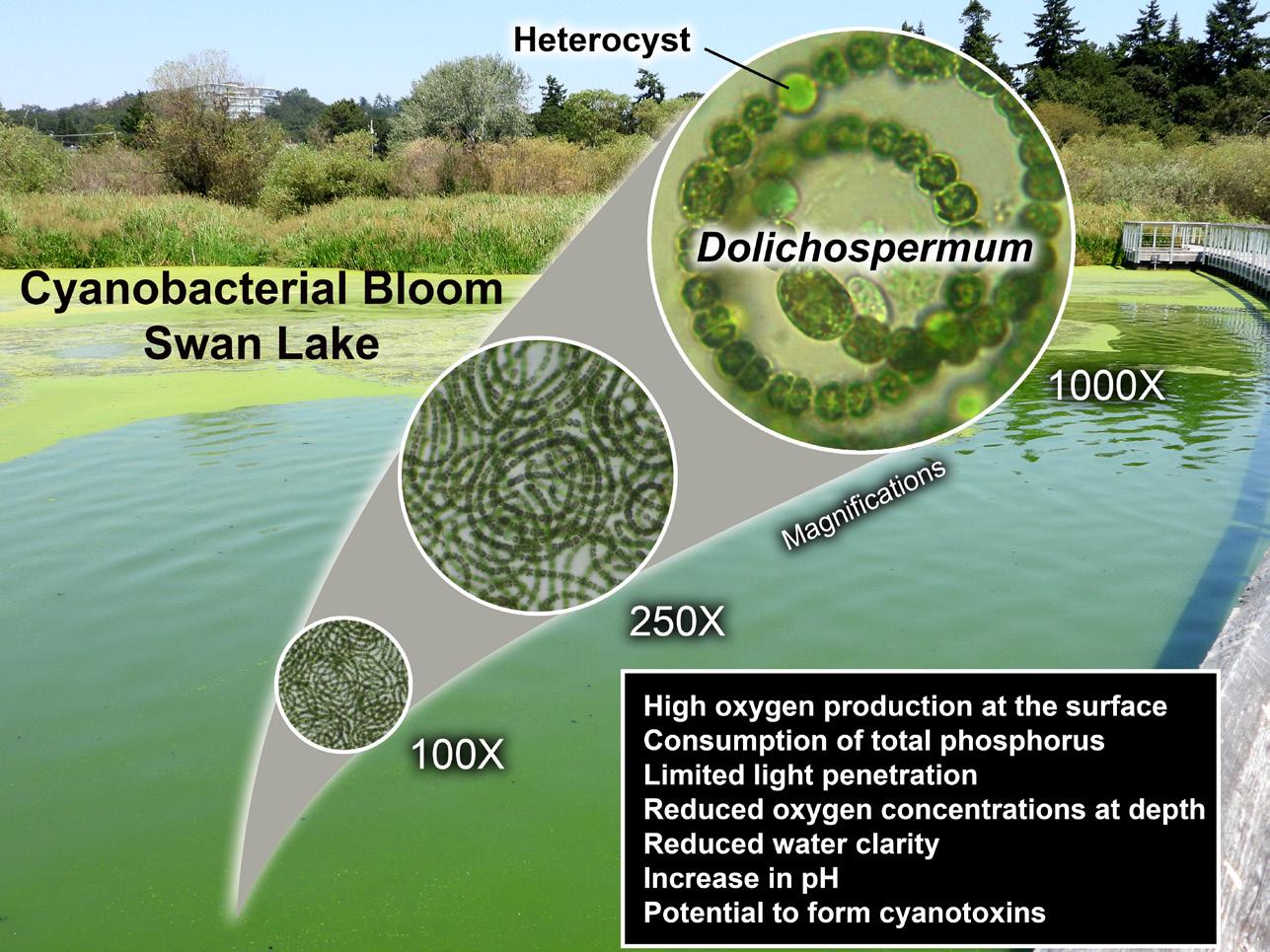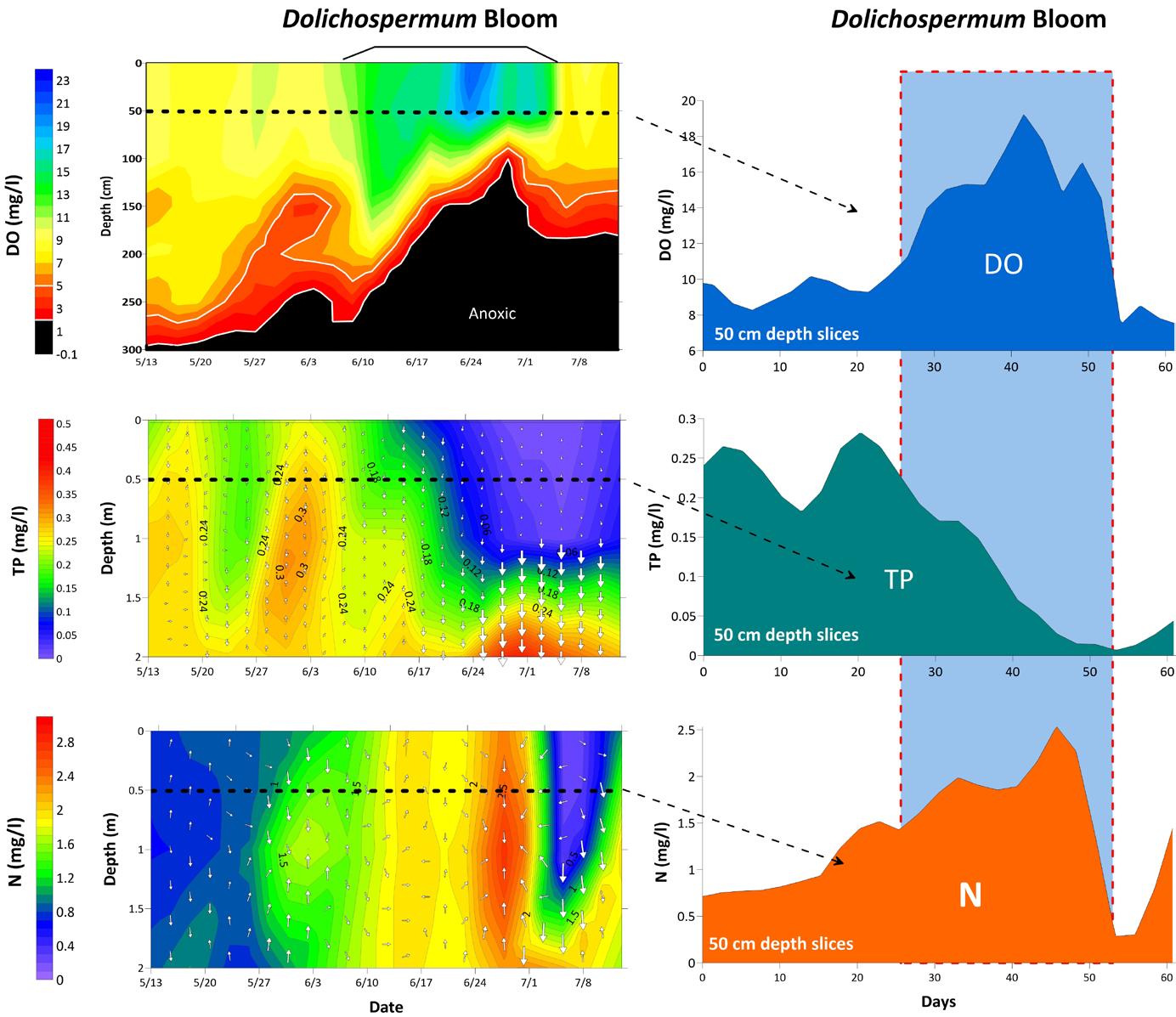
7 minute read
Studying cyanobacterial blooms, nutrients and oxygen in a phosphorus-rich lake
By Robert Bowen
Victoria, British Columbia experienced several record-breaking weather events last year. They included a heat dome, with temperatures reaching over 40°C for several days, a prolonged drought with no precipitation for 51 consecutive days, the lowest atmospheric pressure ever recorded, with associated storms, and a number of atmospheric rivers causing widespread flooding in November, with a rainfall total for the month of 316 mm.
The impact of these atmospheric features tests the resilience of our complex freshwater ecosystems as they try to adjust to unusual physical, chemical and biological forcing. In urban areas, these forces add to the already significant human-induced impacts caused by urbanization, agricultural practices, and the modifications of hydrology as water moves through altered landscapes.
To be able to examine the impact of such forcing, it is important to develop an understanding of the complex nature of interacting systems and exhibited patterns that govern behaviour.
To this end, an ongoing multi-year water quality study has been conducted at Swan Lake, a nine-hectare shallow eutrophic/hypereutrophic lake located within the municipality of Saanich near Victoria, B.C. Swan Lake is far from existing in a steady state, as it undergoes changes that vary over many different time scales, including minute by minute, diurnally, monthly and interannually.
With the onset of the June 2021 heat dome, water temperature values rose to near 30°C. Figure 1 shows one of the lake sites displaying a total of six years of surface and bottom water temperature data. During this period, winds were relatively calm and skies were generally clear. It was at this time that a lake-wide cyanobacterial bloom, dominated by Dolichospermum (formerly known as Anabaena), turned the lake to a bright green hue.
Figure 2 shows this bloom along with some of the important impacts of it on water quality parameters.
During this bloom, the Secchi disk depth test diminished to values as low as 0.2 m. Surface dissolved oxygen (DO) levels rose significantly, as the photosynthetic processes of the Dolichospermum produced remarkably high DO concentrations, exceeding 20 mg/L. The pH values peaked during the heat dome to their highest yearly value of 9.77, a full 1.5 units above pre-bloom conditions.
Of note during this event, the total phosphorus (TP), a nutrient in abundance at this lake (typically in the order of 300 µg/L) saw a sharp decline in concentrations that corresponded with the rise of the bloom. Water samples were taken during this bloom and concentrations of TP and nitrogen were plotted along with profile data of DO in Figure 3.
The Dolichospermum bloom is denoted continued overleaf…
Figure 1. Water temperatures showing the effect of the heat dome on surface water temperatures.
Figure 2. The cyanobacteria Dolichospermum in bloom June 29, 2021.

by the elevated DO concentrations in the surface and near surface waters. As the bloom developed, the anoxic layer at the lake bottom expanded, creating an abrupt DO gradient. Comparing the progression of the bloom as indicated by the DO contours, note the TP concentration began to diminish with a slight lag time.
As the Dolichospermum produced glucose and oxygen as a byproduct of photosynthesis, phosphorus was also consumed. To better understand the dynamics of phosphorus migration, vectors were mapped onto the contours to indicate gradients or the flow of phosphorus in the water column.
Arrows point in the direction of higher concentrations and the size of the arrow indicates the relative magnitude of the gradient. Note the downward migration of TP as the bloom progressed in time, suggesting that as the Dolichospermum die off and drop to the bottom, the TP is taken with it. The slices to the right of the contour plots show an inverse relationship between DO and TP until the peak DO concentration.
Specialized cells within the Dolichospermum colony called heterocysts have the ability to fix nitrogen from their surrounding environment (see Figure

Figure 3. Dissolved oxygen and total phosphorus contour plots with corresponding cross section slices through the 50 cm depth.
2). These cells share this nutrient with adjacent cells in exchange for glucose produced by the colony’s photosynthetic cells. In this example, as the TP concentration is drawn down through metabolic processes, it appears that the Dolichospermum colonies ramp up their production of nitrogen to supply their photosynthetic nutrient requirements to produce glucose.
The bloom lasted about 26 days, with its most intense peak occurring in the last week of June, during the highest air temperature values of the year. The die-off of the bloom occurred when both TP and nitrogen values collapsed. This coincided with the end of the heat dome, when surface water temperatures dropped 4°C over a four-day period and the Secchi disk test depth improved to approximately 0.9 m.
As Swan Lake has high TP concentrations, water samples were taken to examine the vertical distribution of TP right down to the 3.0 m depth lake bottom. This was done in October when much of the surface algal growth had died back and the strong DO, pH and temperature gradients had diminished due to the fall storm mixing events.
The bottom accumulation of dead algae laden with TP produced values as

FORALLYOURCONFINED SPACEENTRYREQUIREMENTS: •BREATHINGAPPARATUS •GASDETECTION •FALLPROTECTION •COMMUNICATIONEQUIPMENT •MANHOLEEQUIPMENT •HOISTS/TRIPODS •LIGHTING •VENTILATION •SHELTERS •MINIATUREWATERPROOFVIDEOCAMERA Andmore……
#3 – 2865 Argentia Rd. Mississauga ON, L5N 8G6 (800) 265-0182 info@cdnsafety.com www.cdnsafety.com
high as 1.35 mg/L. These concentrations were more than four times that of the spring surface waters.
Benthic bacteria at this interface convert organic phosphorus found within dead plant and animal material back into inorganic phosphorus through decomposition. It is this form of phosphorus that is readily available for plant uptake, completing the aquatic phosphorus cycle.
From an aquatic health perspective, phosphorus in freshwater lakes has been referred to as a “biochemical engine”. As there is no phosphorus in the atmosphere, phosphorus enters the aquatic environment either through external loading via inflow creeks and rivers, surface runoff, groundwater movement, or through internal loading due to legacy phosphorus accumulated in benthic sediments.
For the biochemical engine analogy, the external loading is like the engine’s power supply and the internal loading is like the engine’s battery. Swan Lake has very high values of phosphorus both from external and internal loading and falls within the trophic status of eutrophic to hypereutrophic.
The lake exhibits significant oscillations in DO concentrations, lake-wide algal blooms and, in the past, hypoxic fish kills. With each successive year of field observations and data collections, patterns are emerging, resulting in a greater understanding of the processes at work within this nutrient-rich lake.
As this lake is a nature sanctuary, the goal to improve water quality is comparatively broad and not specifically targeted to human activities such as swimming, fishing, or even potable water.
Presently, interventions are being considered to address cyanobacterial blooms and their potential to form hazardous cyanotoxins. One such intervention is the use of ultrasonic frequencies to inhibit the vertical migration of cyanobacteria as they optimize their position in the water column for photosynthesis.
Both Aphanizomenon flos-aquae and Dolichospermum, common species at Swan Lake, regulate their position in the water column by inflating or ballasting vacuoles. This diurnal migration was observed in the data obtained from the 2018 study at Swan Lake using the acoustic zooplankton fish profile (AZFP). This instrument uses acoustic beams to examine backscatter within the water column. This species was verified by net samples and drop down camera images. The use of ultrasonic frequencies in many settings has been effective at interrupting this vertical migration, thereby reducing the cyanobacteria’s ability to increase to bloom status. Adopting this technique at Swan Lake may improve the significant algal problems typically experienced each summer and discussions are ongoing to determine its possible trial use in an isolated area of the lake to compare cyanobacterial growth with other parts of the lake.
This top-down strategy of addressing the cyanobacterial issues directly is only one part of the interventions needed to improve water quality at Swan Lake. Further research is needed to consider bottom-up strategies that would reduce the high levels of phosphorus within the lake.
Funding for this water quality monitoring program was provided by Swan Lake Christmas Hill Nature Sanctuary.
Robert Bowen is with Diversified Scientific Solutions. Email: rgbowen2@gmail.com, or visit: www.dssolutions.bc.ca











